Study on Rheological Properties of Bituminous Binders and Mixtures Containing Waste Printed Circuit Boards (PCBs) and SBR Compound Modified Bitumen
Abstract
1. Introduction
2. Materials and Methods
2.1. Materials
2.2. Preparation of Test Samples
2.2.1. Preparation of Modified Bitumen
2.2.2. Mixture Design
2.2.3. Optimum Proportion of Bitumen
2.3. Properties Evaluation
2.3.1. Physical Property Test
2.3.2. BBR Test
2.3.3. Temperature Sweep Test
2.3.4. Frequency Sweep Test
2.3.5. Multiple Stress Creep and Recovery Test (MSCR)
2.3.6. Fourier-Transform Infrared Spectroscopy (FT-IR)
2.3.7. Fluorescence Microscopy (FM)
2.3.8. Marshall Test
2.3.9. Wheel Test
2.3.10. Bending Beam Test
3. Results and Discussion
3.1. Physical Properties
3.2. Rheological Properties
3.2.1. Temperature Sweep
3.2.2. Frequency Sweep
3.2.3. Permanent Deformation Resistance Evaluation by MSCR
3.3. Mechanism Investigation
3.3.1. Chemical Characterization
3.3.2. PS-Modified Bitumen Dispersing Properties Analysis by FM
3.4. Bituminous Mixtures Performance
3.4.1. Water Stability Analysis
3.4.2. Analysis of High Temperature Rutting Resistance
3.4.3. Analysis of Crack Resistance at Low Temperature
3.5. Correlation Analysis between Bitumen and Bituminous Mixture
4. Conclusions
Author Contributions
Funding
Institutional Review Board Statement
Informed Consent Statement
Data Availability Statement
Conflicts of Interest
References
- Baldé, C.; Forti, V.; Gray, V.; Kuehr, R.; Stegmann, P. The Global E-Waste Monitor 2017: Quantities, Flows, and Resources; United Nations University (UNU), International Telecommunication Union (ITU) & International Solid Waste Association (ISWA): Bonn, Germany; Geneva, Vienna, 2017. [Google Scholar]
- Tan, Q.; Liu, L.; Yu, M.; Li, J. An innovative method of recycling metals in printed circuit board (PCB) using solutions from PCB production. J. Hazard. Mater. 2020, 390, 121892. [Google Scholar] [CrossRef]
- Shi, J.; Xiang, L.; Luan, H.; Wei, Y.; Ren, H.; Chen, P. The health concern of polychlorinated biphenyls (PCBs) in a notorious e-waste recycling site. Ecotoxicol. Environ. Saf. 2019, 186, 109817. [Google Scholar] [CrossRef]
- Kumar, A.; Holuszko, M.; Espinosa, D. E-waste: An overview on generation, collection, legislation and re-cycling practices. Resour. Conserv. Recycl. 2017, 122, 32–42. [Google Scholar] [CrossRef]
- Choubey, P.K.; Panda, R.; Jha, M.K.; Lee, J.-C.; Pathak, D. Recovery of copper and recycling of acid from the leach liquor of discarded Printed Circuit Boards (PCBs). Sep. Purif. Technol. 2015, 156, 269–275. [Google Scholar] [CrossRef]
- Rocchetti, L.; Amato, A.; Beolchini, F. Printed circuit board recycling: A patent review. J. Clean. Prod. 2018, 178, 814–832. [Google Scholar] [CrossRef]
- Hadi, P.; Xu, M.; Lin, C.S.; Hui, C.-W.; McKay, G. Waste printed circuit board recycling techniques and product utilization. J. Hazard. Mater. 2015, 283, 234–243. [Google Scholar] [CrossRef] [PubMed]
- Li, W.; Zhi, Y.; Dong, Q.; Liu, L.; Li, J.; Liu, S.; Xie, H. Research Progress on the Recycling Technology for Nonmetallic Materials from Wasted Printed Circuit Board. Procedia Environ. Sci. 2012, 16, 569–575. [Google Scholar] [CrossRef][Green Version]
- Nie, C.-C.; Wang, Y.-Y.; Zhang, H.; Zhang, Y.-K.; Zhang, Y.-Q.; Yan, Z.-Q.; Li, B.; Lyu, X.-J.; Tao, Y.-J.; Qiu, J.; et al. Cleaner utilization of non-metallic components in separation tailings of waste printed circuit board: Pyrolysis oil, calorific value and building aggregate. J. Clean. Prod. 2020, 258, 120976. [Google Scholar] [CrossRef]
- Cong, P.; Luo, W.; Xu, P.; Zhang, Y. Chemical and physical properties of hot mixing epoxy asphalt binders. Constr. Build. Mater. 2019, 198, 1–9. [Google Scholar] [CrossRef]
- Duan, H.; Hou, K.; Li, J.; Zhu, X. Examining the technology acceptance for dismantling of waste printed circuit boards in light of recycling and environmental concerns. J. Environ. Manag. 2011, 92, 392–399. [Google Scholar] [CrossRef]
- Hu, D.; Luo, Y.; Lin, J.; Chen, Y.; Jia, D. Reutilization of waste printed circuit boards nonmetallic powders in elastomer composites: Significant improvements of curing and mechanical properties. Polym. Compos. 2020, 41, 2224–2232. [Google Scholar] [CrossRef]
- Hadi, P.; Ning, C.; Ouyang, W.; Xu, M.; Lin, C.S.; McKay, G. Toward environmentally-benign utilization of nonmetallic fraction of waste printed circuit boards as modifier and precursor. Waste Manag. 2015, 35, 236–246. [Google Scholar] [CrossRef]
- Carlos, S.; Pedro, L.; Pablo, P.; Daniel, C. Mechanical performance of fibers in hot mix asphalt: A review. Construct. Build. Mater. 2019, 200, 756–769. [Google Scholar]
- Yang, F.; Sun, S.; Zhong, S.; Li, S.; Wang, Y.; Wu, J. Performance of the heavy fraction of pyrolysis oil derived from waste printed circuit boards in modifying asphalt. J. Environ. Manag. 2013, 126, 1–6. [Google Scholar] [CrossRef]
- Guo, J.; Guo, J.; Wang, S.; Xu, Z. Asphalt modified with nonmetals separated from pulverized waste printed circuit boards. Environ. Sci. Technol. 2009, 43, 503–508. [Google Scholar] [CrossRef]
- Dong, F.; Yu, X.; Chen, J.; Liu, S.; Chen, Q. Investigation on compatibility and microstructure of PCBs-modified asphalt. J. Appl. Polym. Sci. 2017, 134. [Google Scholar] [CrossRef]
- Abbaszadeh, M.; Khodadadian, A.; Parvizi, M.; Dehghan, M.; Heitzinger, C. A direct meshless local collocation method for solving stochastic cahnhilliard–cook and stochastic swift–hohenberg equations. Eng. Anal. Bound Elem. 2018, 98, 253–264. [Google Scholar] [CrossRef]
- Khodadadian, A.; Parvizi, M.; Abbaszadeh, M.; Dehghan, M.; Heitzinger, C. A multilevel Monte Carlo finite element method for the stochastic Cahn–Hilliard–Cook equation. Comput. Mech. 2019, 64, 937–949. [Google Scholar] [CrossRef]
- Yildirim, Y. Polymer modified asphalt binders. Constr. Build. Mater. 2007, 21, 66–72. [Google Scholar] [CrossRef]
- Zhang, F.; Hu, C. The research for SBS and SBR compound modified asphalts with polyphosphoric acid and sulfur. Constr. Build. Mater. 2013, 43, 461–468. [Google Scholar] [CrossRef]
- Li, Y.; Cheng, P.; Elfadil, A. Effect of phenolic resin on the performance of the styrene-butadiene rubber modified asphalt. Construct. Build. Mater. 2018, 181, 465–473. [Google Scholar]
- Liang, P.; Liang, M.; Fan, W.; Zhang, Y.; Qian, C.; Ren, S. Improving thermo-rheological behavior and compatibility of SBR modified asphalt by addition of polyphosphoric acid (PPA). Constr. Build. Mater. 2017, 139, 183–192. [Google Scholar] [CrossRef]
- Zhu, C.; Zhang, H.; Xu, G.; Shi, C. Aging rheological characteristics of SBR modified asphalt with mul-ti-dimensional nanomaterials. Construct. Build. Mater. 2017, 151, 388–393. [Google Scholar] [CrossRef]
- JTG E42-2005. Test Methods of Aggregate for Engineering. 2005. Available online: https://www.codeofchina.com/standard/JTGE42-2005.html (accessed on 30 March 2021).
- Standard, Chinese. Standard Test Methods of Bitumen and Bituminous Mixtures for Highway Engineering; JTG E20-2011; Ministry of Transport of the People’s Republic of China: Beijing, China, 2011.
- Zhang, H.; Chen, Z.; Xu, G.; Shi, C. Evaluation of aging behaviors of asphalt binders through different rheological indices. Fuel 2018, 221, 78–88. [Google Scholar] [CrossRef]
- Zhang, R.; Wang, H.; Gao, J.; You, Z.; Yang, X. High temperature performance of SBS modified bio-asphalt. Constr. Build. Mater. 2017, 144, 99–105. [Google Scholar] [CrossRef]
- Yong, L.; Wang, H.; Ellie, H.F.; You, Z.; Xu, Y.; Guo, J.; Shi, D.; Guan, J. Evaluation of the effect of bio-oil on the high-temperature performance of rubber modified asphalt. Construct. Build. Mater. 2018, 191, 692–701. [Google Scholar]
- Xu, Y.; You, Z. High temperature performance evaluation of bio-oil modified asphalt binders using the DSR and MSCR tests. Construct. Build. Mater. 2015, 76, 380–387. [Google Scholar]
- Lv, S.; Peng, X.; Liu, C.; Qu, F.; Zhu, X.; Tian, W.; Zheng, J. Aging resistance evaluation of asphalt modified by Buton-rock asphalt and bio-oil based on the rheological and microscopic characteristics. J. Clean. Prod. 2020, 257, 120589. [Google Scholar] [CrossRef]
- Kumar, R.; Saboo, N.; Kumar, P.; Chandra, S. Effect of warm mix additives on creep and recovery response of conventional and polymer modified asphalt binders. Constr. Build. Mater. 2017, 138, 352–362. [Google Scholar] [CrossRef]
- Li, X.; Jian, C.; Que, G. Microstructure and performance of crumb rubber modified asphalt. Construct. Build. Mater. 2009, 23, 3586–3590. [Google Scholar]
- Ren, R.; Han, K.; Zhao, P.; Shi, J.; Zhao, L.; Gao, D.; Zhang, Z.; Yang, Z. Identification of asphalt fingerprints based on ATR-FTIR spectroscopy and principal component-linear discriminant analysis. Constr. Build. Mater. 2019, 198, 662–668. [Google Scholar] [CrossRef]
- Jing, L.; Zhang, F.; Yu, L.; Yaseen, M.; Su, Z.; Fei, M.; Chen, X. Preparation and properties of soybean bio-asphalt/SBS modified petroleum asphalt. Construct. Build. Mater. 2019, 201, 268–277. [Google Scholar]
- Ming, L.; Xue, X.; Fan, W.; Hao, W.; Wei, S. Phase field simulation and microscopic observation of phase separation and thermal stability of polymer modified asphalt. Construct. Build. Mater. 2019, 204, 132–143. [Google Scholar]
- Khodadadian, A.; Noii, N.; Parvizi, M.; Abbaszadeh, M.; Wick, T.; Heitzinger, C. A Bayesian estimation method for variational phase-field fracture problems. Comput. Mech. 2020, 66, 827–849. [Google Scholar] [CrossRef] [PubMed]
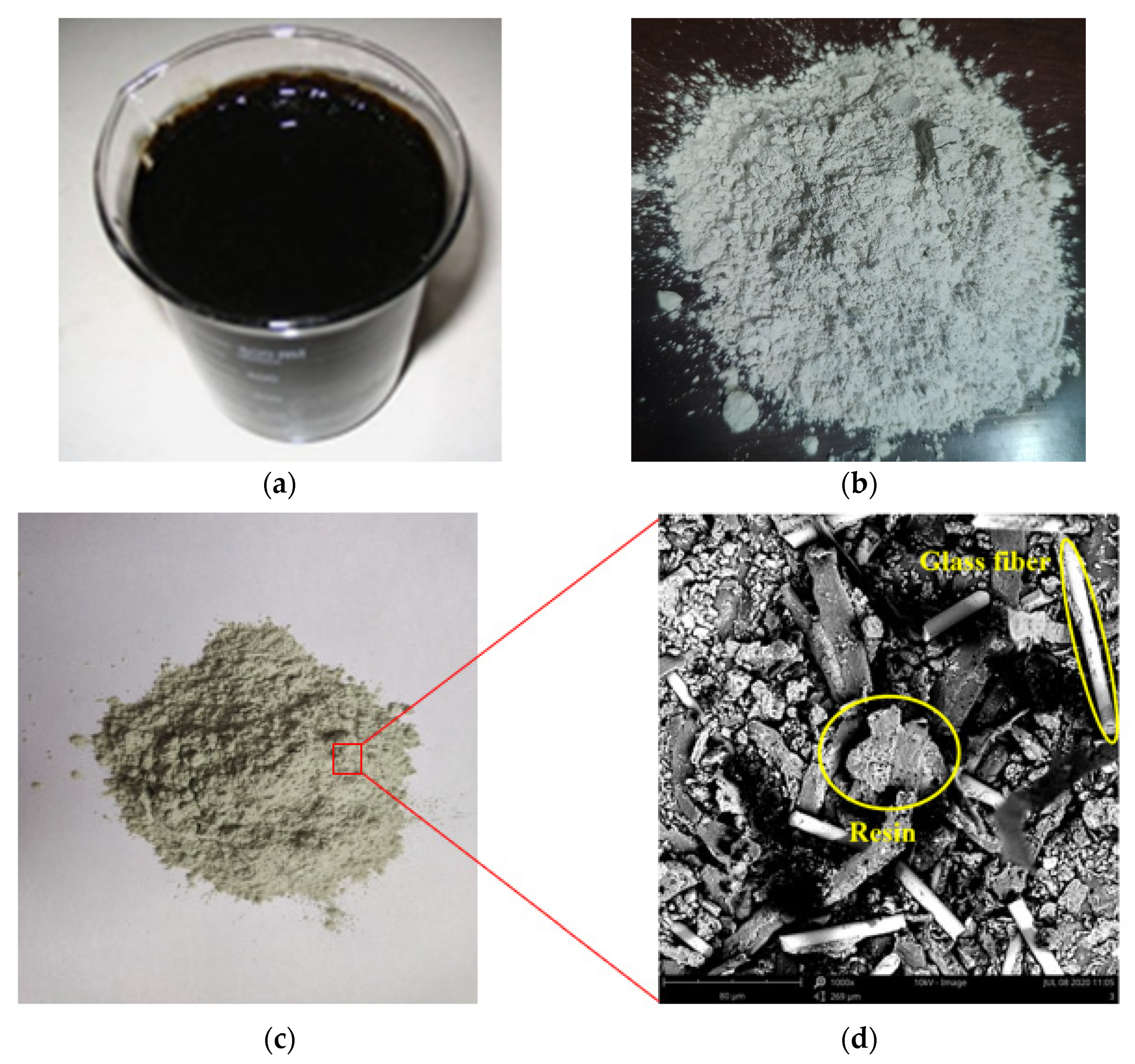
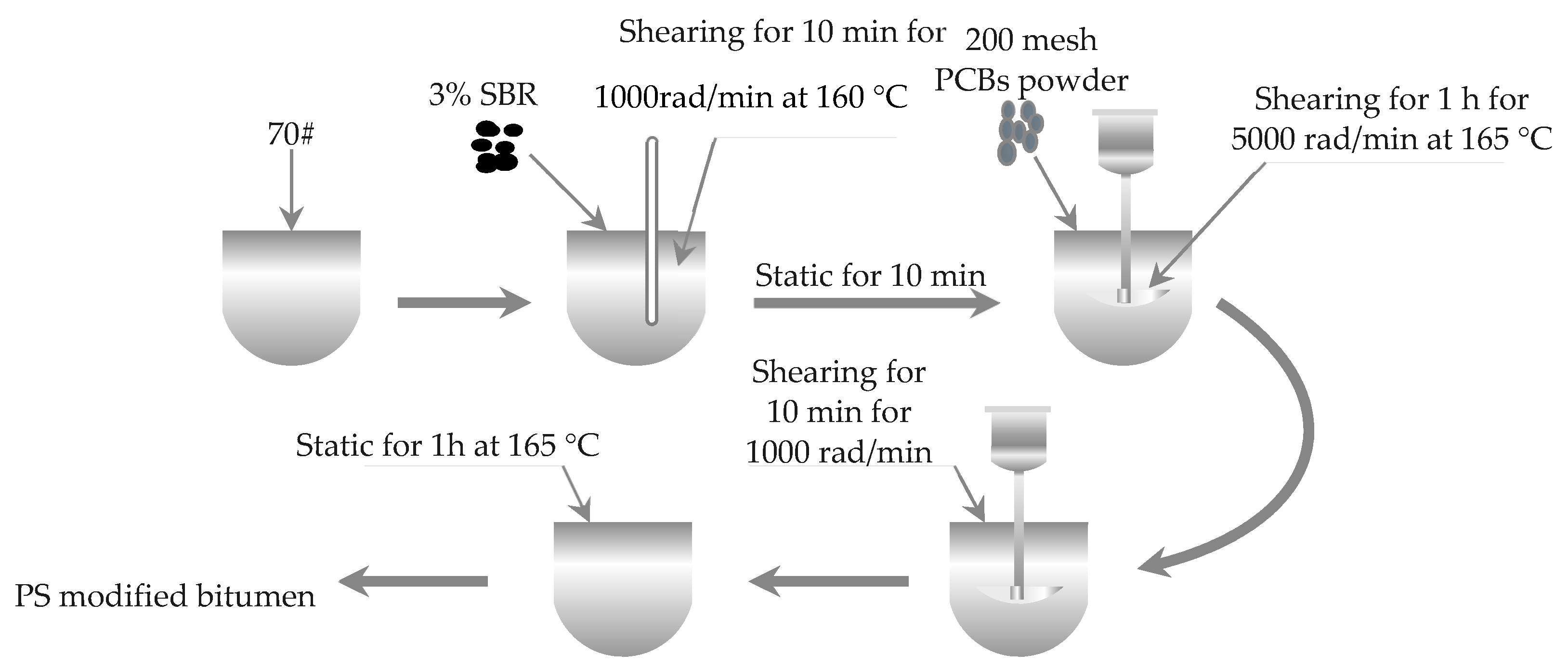
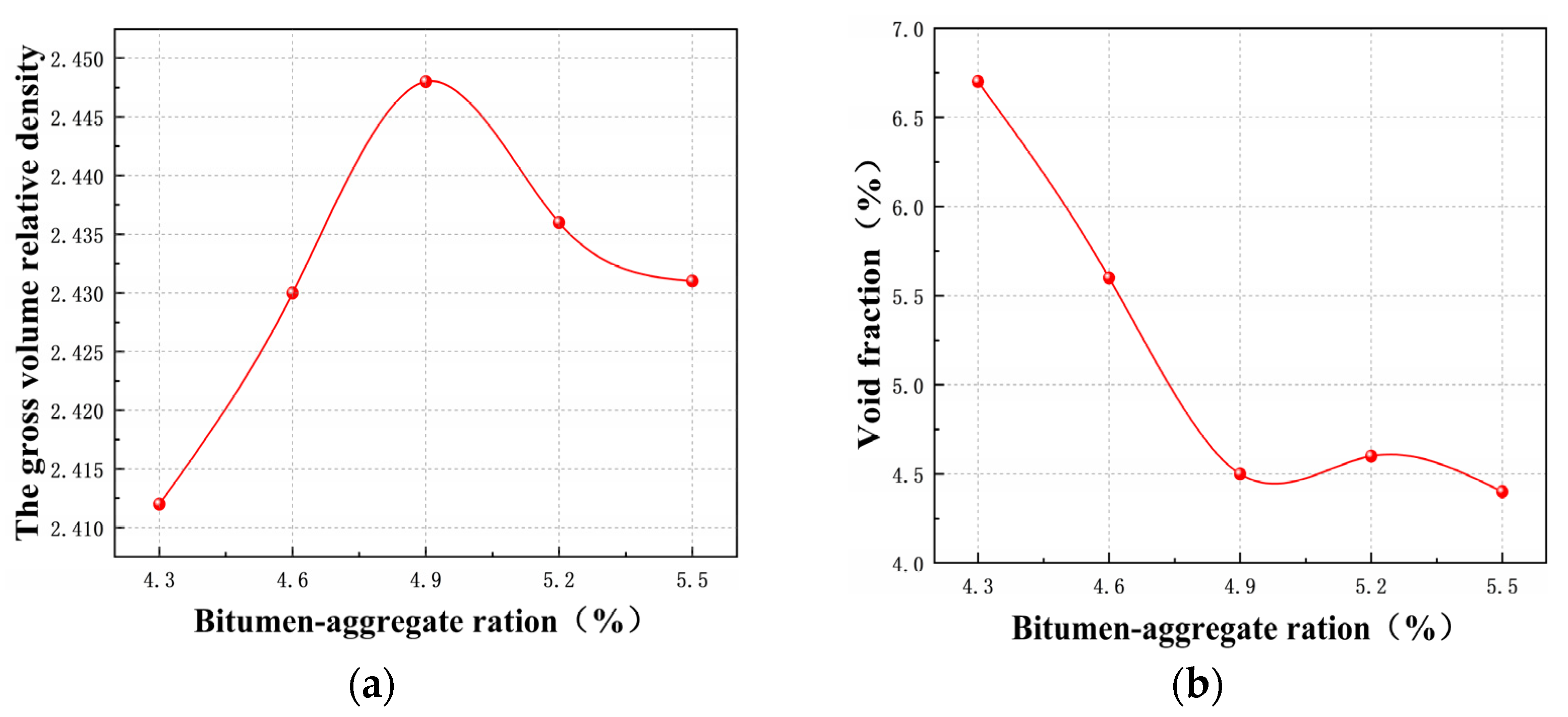
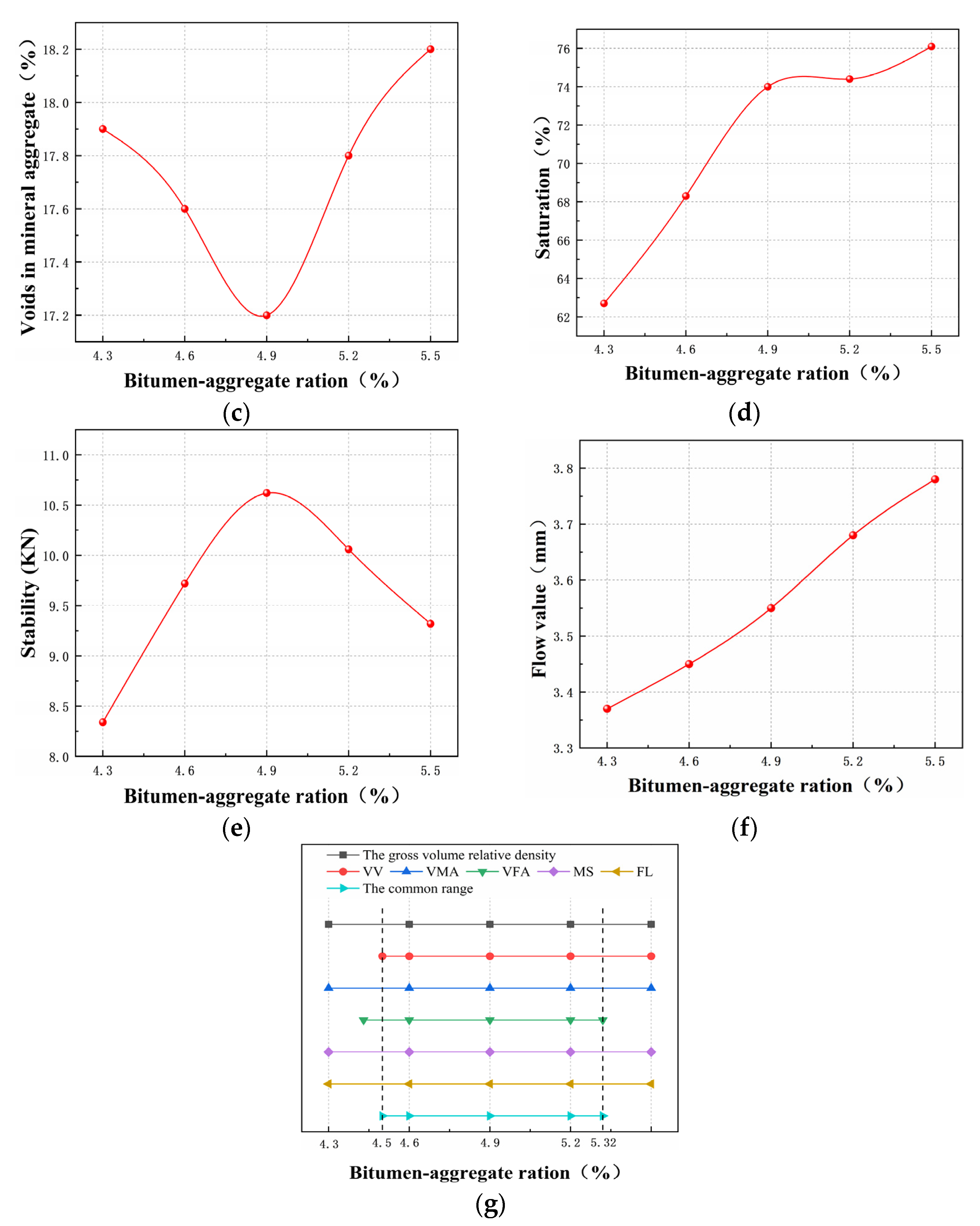

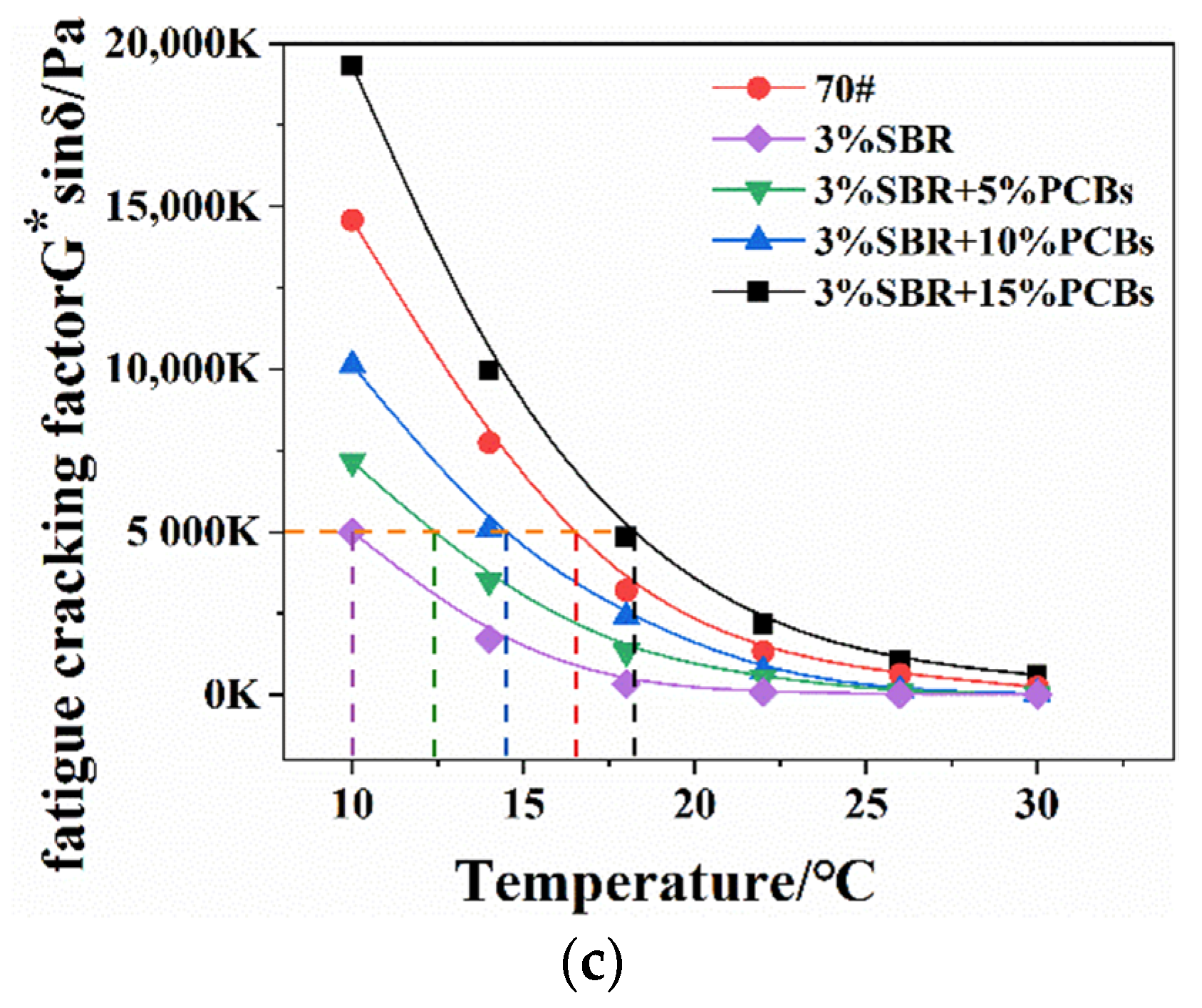
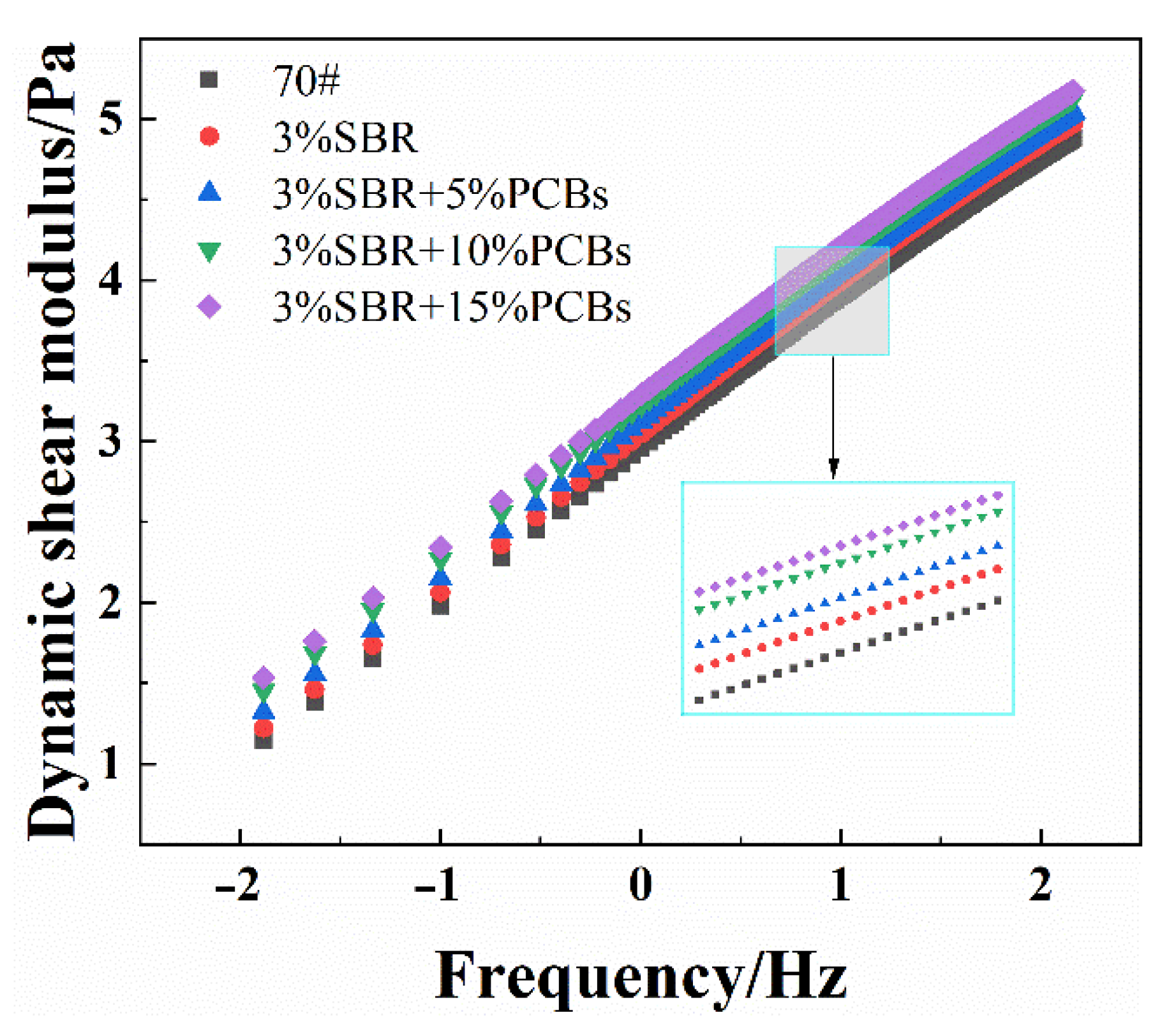
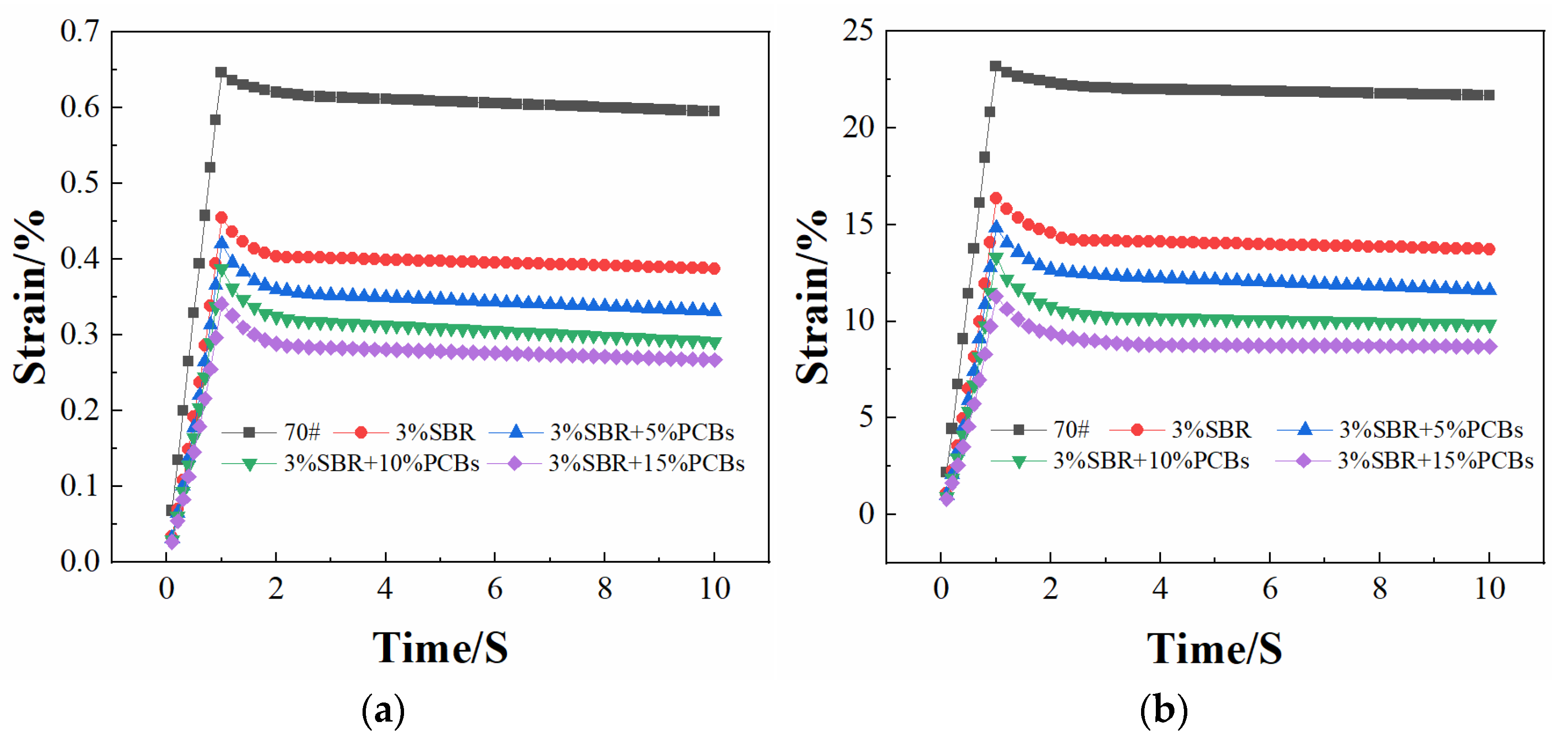
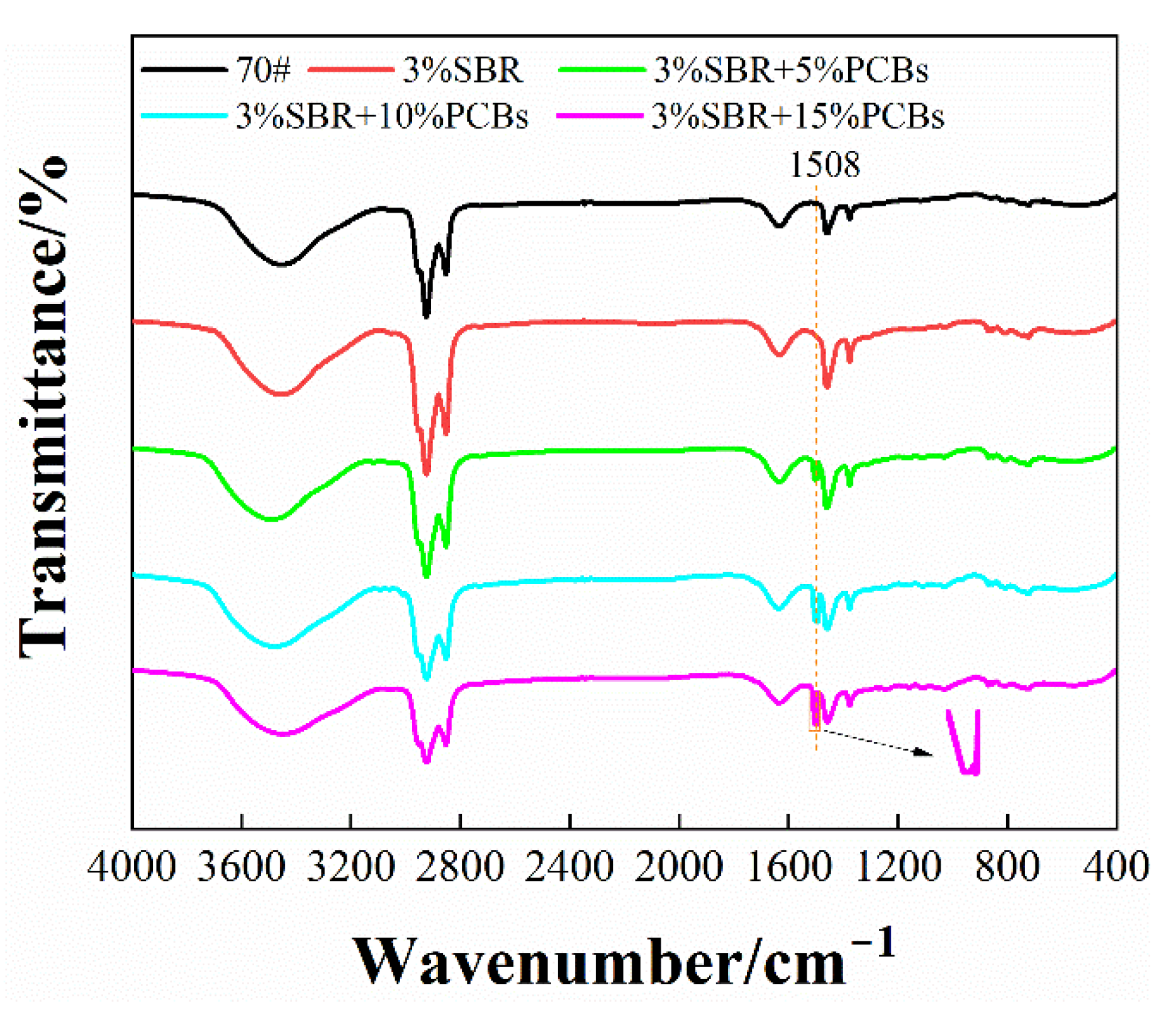
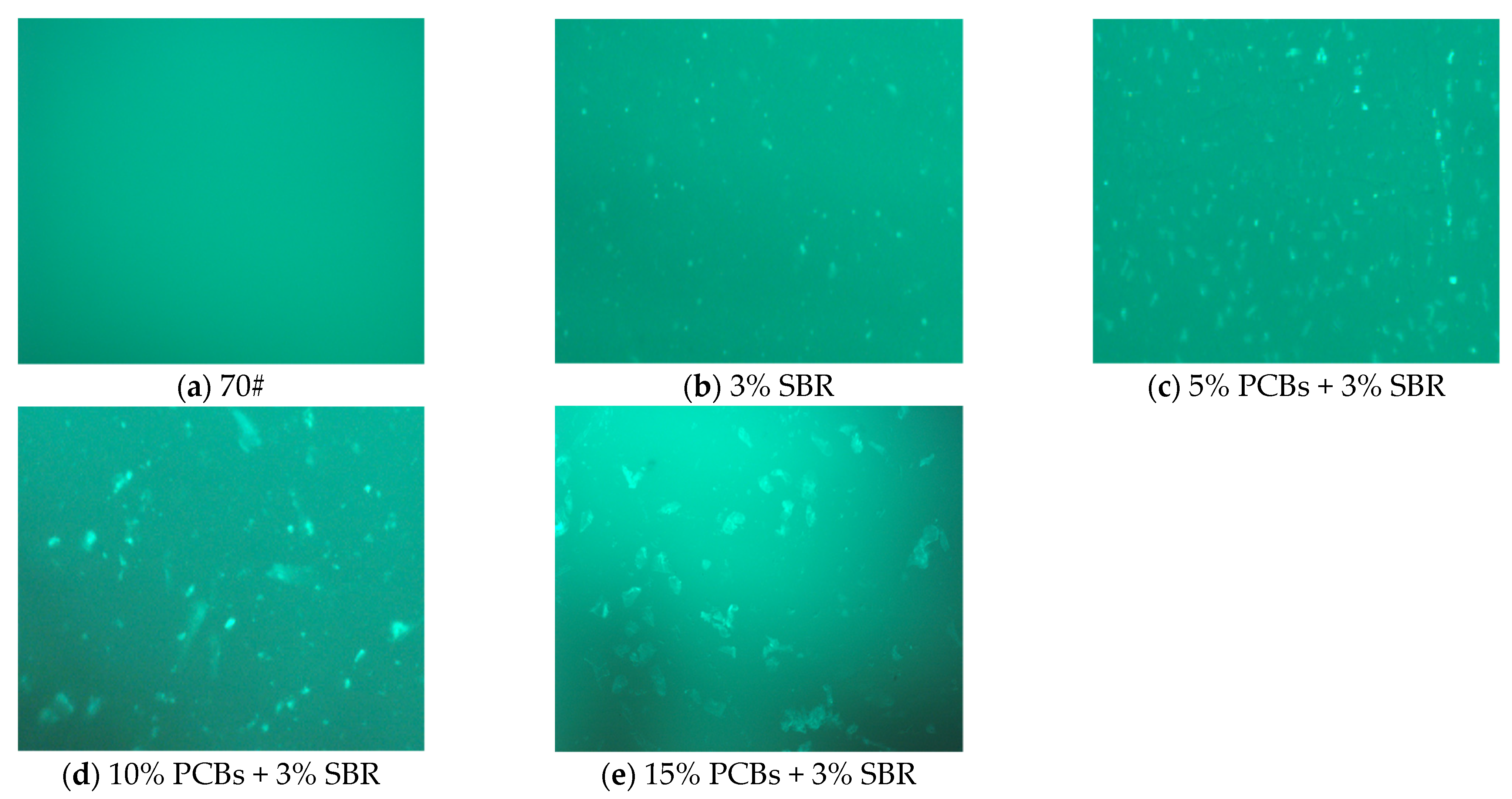
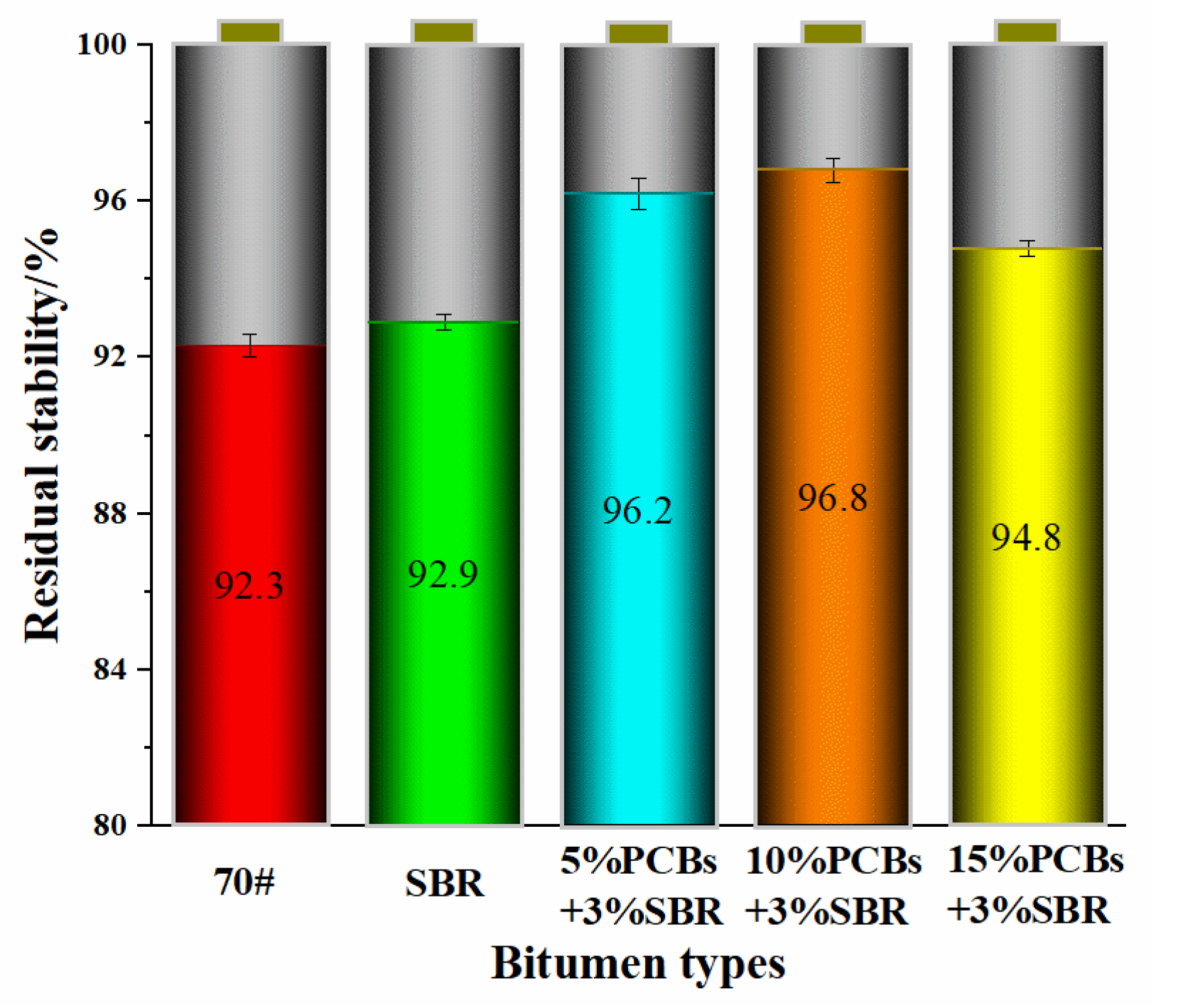
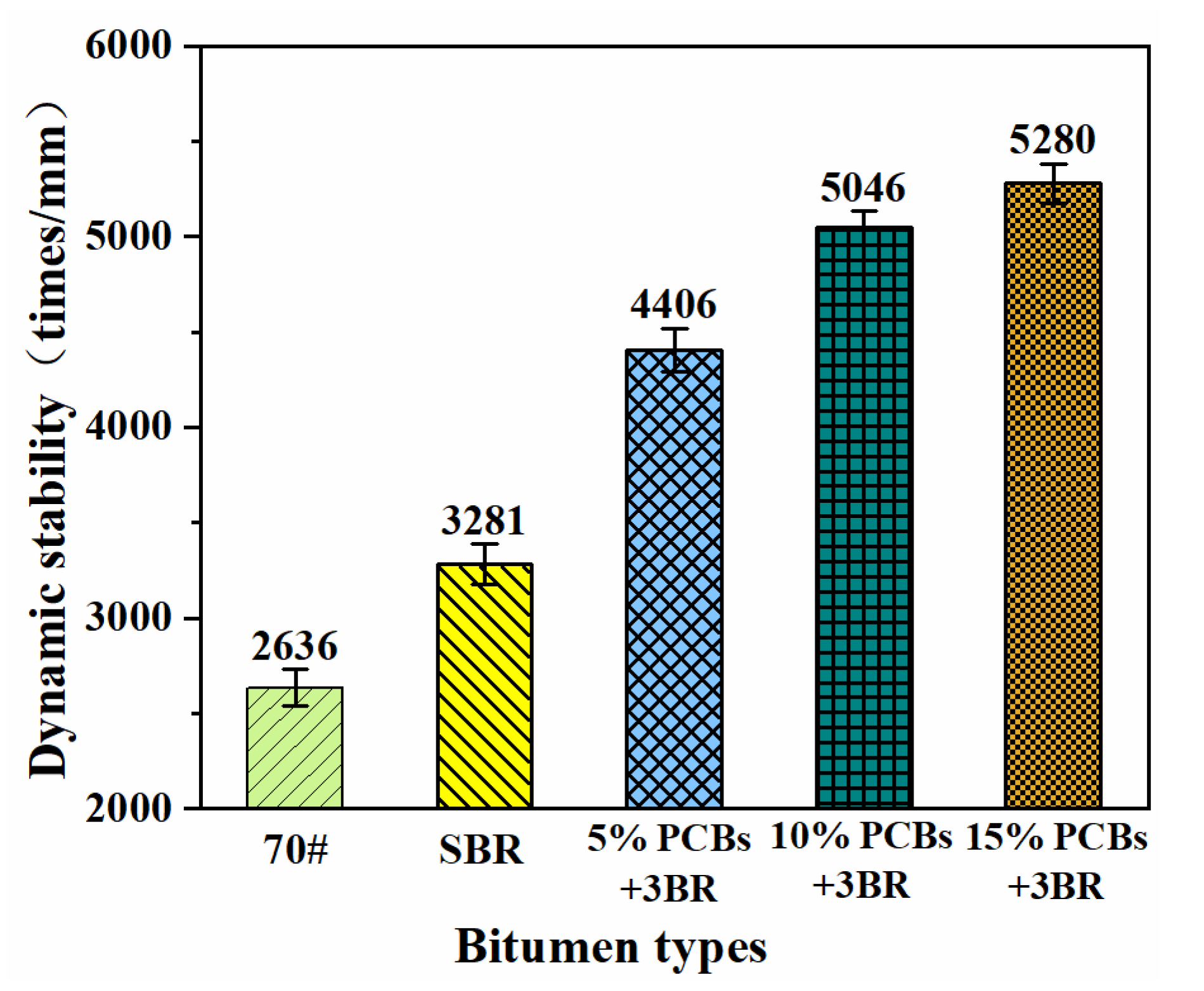
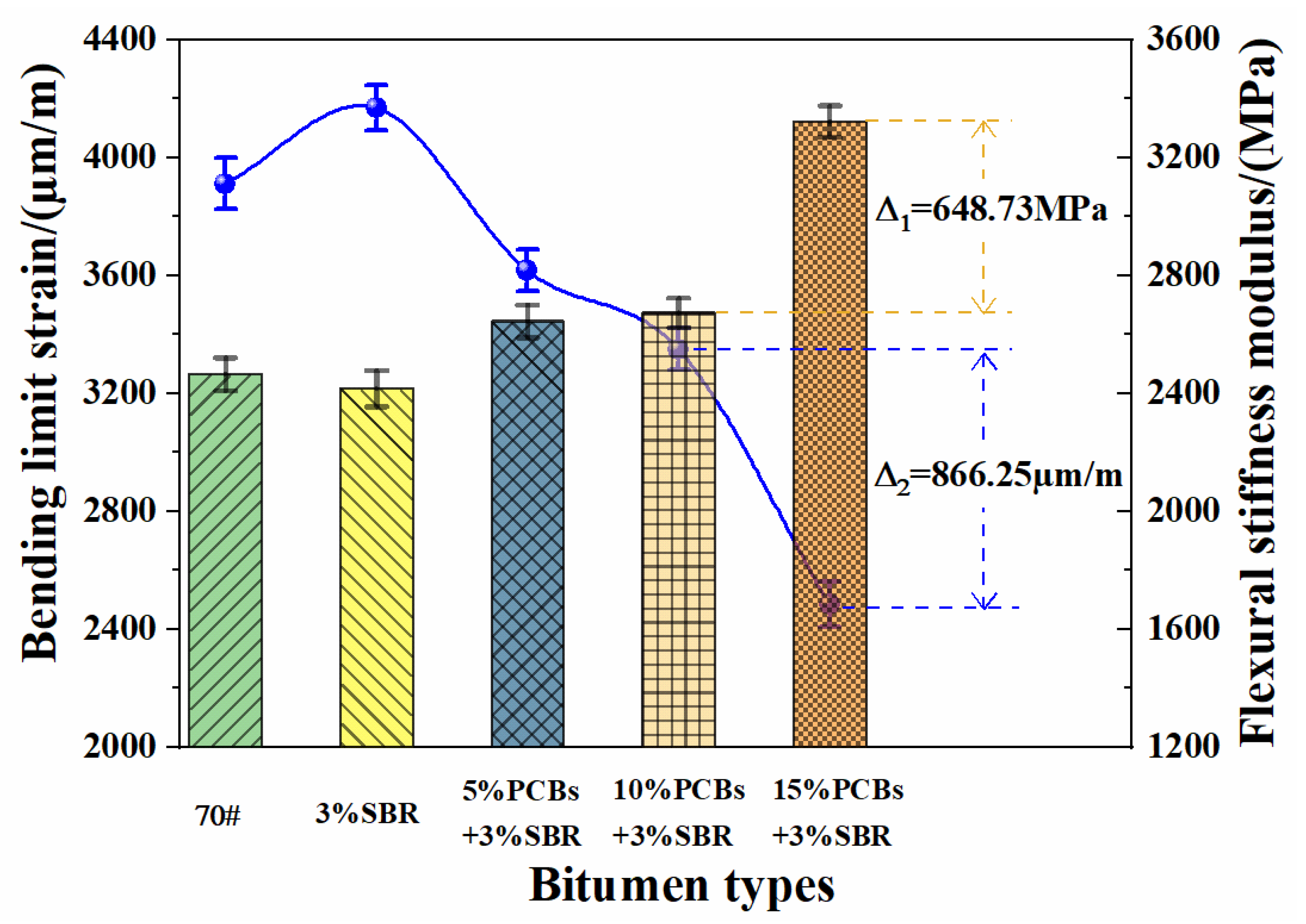
| Properties Index | Results | Standard | Methods | |
|---|---|---|---|---|
| Penetration (25 °C, 100 g, 5 s)/0.1 mm | 67.0 | 60~80 | T0604-2011 | |
| Ductility (5 °C, 5 cm/min)/cm | 11.3 | - | T0605-2011 | |
| Softening point (TR&B)/°C | 50.0 | ≥46 | T0606-2011 | |
| Viscosity (135 °C)/Pa·s | 0.49 | <3 | T0625-2011 | |
| Rolling thin film oven aged, RTFO (163 °C, 5 h) | Mass loss | −0.313 | ≤0.8 | T0609-2011 |
| Penetration (25 °C) | 64.3 | ≥61 | T0604-2011 | |
| Items | Standard | Standard | Methods |
|---|---|---|---|
| Volatile/% | ≤0.90 | 0.20 | GB/T6737 |
| Ash/% | ≤0.50 | 0.10 | GB/T4498 |
| Organic acid/% | 4.5~6.75 | 6.25 | GB/T8657 |
| Bound styrene/% | 22.5~24.5 | 23.8 | GB/T8658 |
| Breaking elongation/% | ≥330 | 407 | GB/T528 |
| Tensile strength/MPa | ≥24.5 | 26.7 | GB/T528 |
| Mooney viscosity of rubber compound/Pa·s | ≤93 | 80 | GB/T1232.1 |
| Properties Index | Standard | Results | Methods |
|---|---|---|---|
| Crushing value (%) | ≤26 | 14.5 | T0316 |
| Los Angeles attrition loss (%) | ≤28 | 11.7 | T0317 |
| Apparent relative density (g/cm3) | ≥2.60 | 3.13 | T0304 |
| Relative density of gross volume (g/cm3) | - | 2.967 | T0304 |
| Acicular and flaky grain (%) | ≤15 | 9.2 | T0312 |
| Water absorption (%) | ≤2.0 | 0.9 | T0304 |
| Particle content less than 0.075 mm (%) | ≤1 | 0.2 | T0310 |
| Sediment percentage (%) | ≤1 | 0.6 | T0310 |
| Properties Index | Standard | Results | Methods |
|---|---|---|---|
| Apparent relative density (g/cm3) | ≥2.50 | 2.708 | T0328 |
| Sand equivalent (%) | ≥60 | 65 | T0334 |
| Particle content less than 0.075 mm (%) | ≤3 | 1.2 | T0333 |
| Properties Index | Standard | Results | Methods |
|---|---|---|---|
| Apparent density (g/cm3) | ≥2.50 | 2.600 | T0352 |
| Particle content less than 0.075 mm (%) | 75~100 | 89.5 | T0351 |
| Water content | ≤1 | 0.3 | T0103 |
| Hydrophilic coefficient | ≤1 | 0.68 | T0353 |
| Heating stability at 200 °C | - | No color change | T0355 |
| Size (mm) | 16 | 13.2 | 9.5 | 4.75 | 2.36 | 1.18 | 0.6 | 0.3 | 0.15 | 0.075 |
|---|---|---|---|---|---|---|---|---|---|---|
| Maximum pass (%) | 100 | 100 | 85 | 68 | 50 | 38 | 28 | 20 | 15 | 8 |
| Minimum pass (%) | 100 | 90 | 68 | 38 | 24 | 15 | 10 | 7 | 5 | 4 |
| Design pass (%) | 100 | 95 | 76.5 | 53 | 32 | 26.5 | 19 | 13.5 | 10 | 6 |
| Index | 70# | 3%SBR | 3%SBR + 5%PCBs | 3%SBR + 10%PCBs | 3%SBR + 15%PCBs |
|---|---|---|---|---|---|
| Penetration (25 °C)/0.1 mm | 67.0 | 64.1 | 57.8 | 47.9 | 46.7 |
| Softening point/°C | 50.0 | 51.8 | 53.3 | 55.1 | 55.6 |
| Viscosity (135 °C)/mPa·s | 490 | 538 | 603 | 845 | 978 |
| Ductility (5 °C)/cm | 11.3 | 12.4 | 12.1 | 11.8 | 10.9 |
| S (t = 60) /MPa | 171.65 | 167.86 | 169.04 | 170.18 | 173.42 |
| m (t = 60) | 0.34 | 0.39 | 0.37 | 0.35 | 0.33 |
| Type | Jnr0.1 (kPa−1) | Jnr3.2 (kPa−1) | Jnr-diff (%) |
|---|---|---|---|
| 70# | 6.19 | 7.23 | 16.83 |
| 3%SBR | 3.88 | 4.77 | 22.99 |
| 3%SBR + 5%PCBs | 3.32 | 3.94 | 18.69 |
| 3%SBR + 10%PCBs | 2.88 | 3.28 | 13.79 |
| 3%SBR + 15%PCBs | 2.67 | 3.00 | 12.18 |
| Type | 1610~1370 cm−1 (%) | 3000~2800 cm−1 (%) | 1508 cm−1 (%) |
|---|---|---|---|
| 70# | 6.28 | 18.59 | - |
| 3%SBR | 8.24 | 25.28 | - |
| 3%SBR + 5%PCBs | 8.78 | 21.76 | 0.83 |
| 3%SBR + 10%PCBs | 9.35 | 18.30 | 1.10 |
| 3%SBR + 15%PCBs | 9.55 | 15.45 | 1.28 |
| Bitumen Type | Softening Point | G*/sinδ | Jnr0.1 | Jnr3.2 | C=C |
|---|---|---|---|---|---|
| 70# | 0.654 | 0.860 | 0.350 | 0.352 | 0.866 |
| 3% SBR | 0.771 | 0.794 | 0.719 | 0.673 | 0.769 |
| 5% PCBs + 3% SBR | 0.930 | 0.999 | 0.760 | 0.771 | 0.997 |
| 10% PCBs + 3% SBR | 0.765 | 0.952 | 0.545 | 0.533 | 0.855 |
| 15% PCBs + 3% SBR | 0.716 | 0.999 | 0.488 | 0.475 | 0.811 |
| R0i | 0.767 | 0.921 | 0.572 | 0.561 | 0.860 |
| Type | 70# | 3% SBR | 5% PCBs + 3% SBR | 10% PCBs + 3% SBR | 15% PCBs + 3% SBR | R0i |
|---|---|---|---|---|---|---|
| Ductility | 0.885 | 0.570 | 0.925 | 0.999 | 0.403 | 0.756 |
Publisher’s Note: MDPI stays neutral with regard to jurisdictional claims in published maps and institutional affiliations. |
© 2021 by the authors. Licensee MDPI, Basel, Switzerland. This article is an open access article distributed under the terms and conditions of the Creative Commons Attribution (CC BY) license (https://creativecommons.org/licenses/by/4.0/).
Share and Cite
Meng, Y.; Liao, Y.; Liu, Z.; Chen, J.; Yang, X.; Rong, H. Study on Rheological Properties of Bituminous Binders and Mixtures Containing Waste Printed Circuit Boards (PCBs) and SBR Compound Modified Bitumen. Materials 2021, 14, 1697. https://doi.org/10.3390/ma14071697
Meng Y, Liao Y, Liu Z, Chen J, Yang X, Rong H. Study on Rheological Properties of Bituminous Binders and Mixtures Containing Waste Printed Circuit Boards (PCBs) and SBR Compound Modified Bitumen. Materials. 2021; 14(7):1697. https://doi.org/10.3390/ma14071697
Chicago/Turabian StyleMeng, Yongjun, Yongjie Liao, Zhirong Liu, Jing Chen, Xiaolong Yang, and Hongliu Rong. 2021. "Study on Rheological Properties of Bituminous Binders and Mixtures Containing Waste Printed Circuit Boards (PCBs) and SBR Compound Modified Bitumen" Materials 14, no. 7: 1697. https://doi.org/10.3390/ma14071697
APA StyleMeng, Y., Liao, Y., Liu, Z., Chen, J., Yang, X., & Rong, H. (2021). Study on Rheological Properties of Bituminous Binders and Mixtures Containing Waste Printed Circuit Boards (PCBs) and SBR Compound Modified Bitumen. Materials, 14(7), 1697. https://doi.org/10.3390/ma14071697









